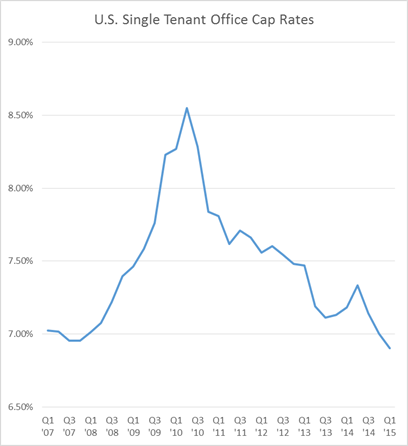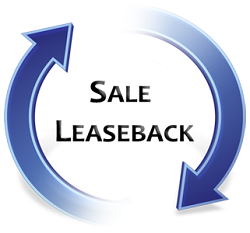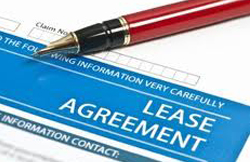The Lure of a Sale-Leaseback
Date: 06/05/2015
Many business leaders are looking at the current economy and market conditions and realizing that this is a good time to consider a sale-leaseback transaction.
 While companies do sale-leasebacks in all types of market conditions, the current high demand from investors for single tenant net lease properties calls for an even closer look. The low interest rates and low returns available with other investment opportunities are driving intense demand for long-term leased real estate. This demand has compressed cap rates (and increased market values) beyond pre-recession prices.
While companies do sale-leasebacks in all types of market conditions, the current high demand from investors for single tenant net lease properties calls for an even closer look. The low interest rates and low returns available with other investment opportunities are driving intense demand for long-term leased real estate. This demand has compressed cap rates (and increased market values) beyond pre-recession prices.
In a sale-leaseback, a company sells a property they occupy for their business and control the property on a long-term lease. The seller, now tenant, has full control of the real estate for whatever initial lease term and renewal options the company chooses to offer.
While there are many factors that impact value in a sale-leaseback transaction, there are some major themes to consider.
- Rental amount – The higher the rent, the higher the value.
- Length of lease – The longer the initial term of the lease, the more value. For example a 20-year initial term creates more value than 10 years.
- Strength of tenant – The higher the credit rating and financial strength of the income stream from the tenant, the more value the property will have.
- Rental rate escalations – Rental increases during the term also create more value. For example, a 2% annual rate escalation creates more value than 1% per year.
- Location – The value of the location, demographics, and barrier to entry can all be factors.
- Age, condition and use – The age of the facility, condition, functional obsolescence, and specific use issues impact value.
- Lease language – The more the lease eliminates potential landlord costs or involvement, the higher the value. Most leases are true triple net so the tenant handles all property operating costs.
- Rental rate compared to market – If the offered rent is too high over market rents, the risk of re-leasing can reduce value.
- Disposition process – The laws of supply and demand impact the value of everything. An effective marketing process can increase value.

There are many benefits to a company in a sale-leaseback transaction.
- Higher returns – Companies typically earn higher returns investing in their business than returns provided by commercial real estate.
- More equity – Selling the property unleashes 100% of the equity to invest in the business. Financing typically unleashes only 70 to 80% of the equity and there are refinance costs every three to five years, plus the burden of balloon payments at loan maturity.
- No covenants – The absence of a loan removes loan covenant issues for the company. This offers more control of financial decisions by the company and removes the risk of violation of these covenants.
- Flexibility – At the end of the initial lease term, the company can exercise a renewal option or simply leave for a better location. The company does not have to sell a vacant building. Vacant buildings have a much smaller buyer pool and can sometimes be difficult to sell.
- Improved balance sheet – The seller replaces a fixed asset (the real estate) with a current asset (the cash proceeds from the sale). If the lease is classified as an operating lease, the seller’s rent obligation usually is disclosed in a footnote to the balance sheet rather than as a liability.
- Potential tax advantages – The seller, now tenant, writes off the full lease expense, rather than just the interest on a loan, and depreciation which must be recaptured.
- Speed – Sale-leasebacks can happen fairly quickly.
- Increased proceeds when selling business – Business sellers realize greater returns in a merger or when selling their business by selling the real estate to highest paying investor prior to selling the business.
When properly structured, a sale-leaseback can be a great tool to increase a company’s returns and value. The high buyer demand and increased values in the current market certainly make it even more interesting to consider. It’s important to engage an experienced real estate broker, attorney and tax professional to structure the transaction for maximum benefit.
-

- Michael Bull, CCIM
- Show Host
- Bull Realty, Inc.
- Website
- (404) 876-1640 x 101
Michael's brokerage services: Bull Realty.com
Michael's video training: Commercial Agent Success.com
2 comments
Trackbacks and pingbacks
No trackback or pingback available for this article.












Not just some major themes to consider but a number of things to consider. Indeed, a luring article. Thanks.
Thanks Michael Bull ! For sharing informative content related to Sale-Leaseback, I personally would like to say here , Basically A sale-leaseback transaction represents another alternative middle market companies can use to raise capital and finance future operations and growth. Properly structured a sale-leaseback can more efficiently use a company’s assets as a financing tool. It is important to work with an experienced team of attorneys, tax professionals and investment bankers to structure a deal that meets the company’s specific circumstances. It is also important to find the right special purpose investors that will provide a market price for the real estate and negotiate a market lease with the seller.